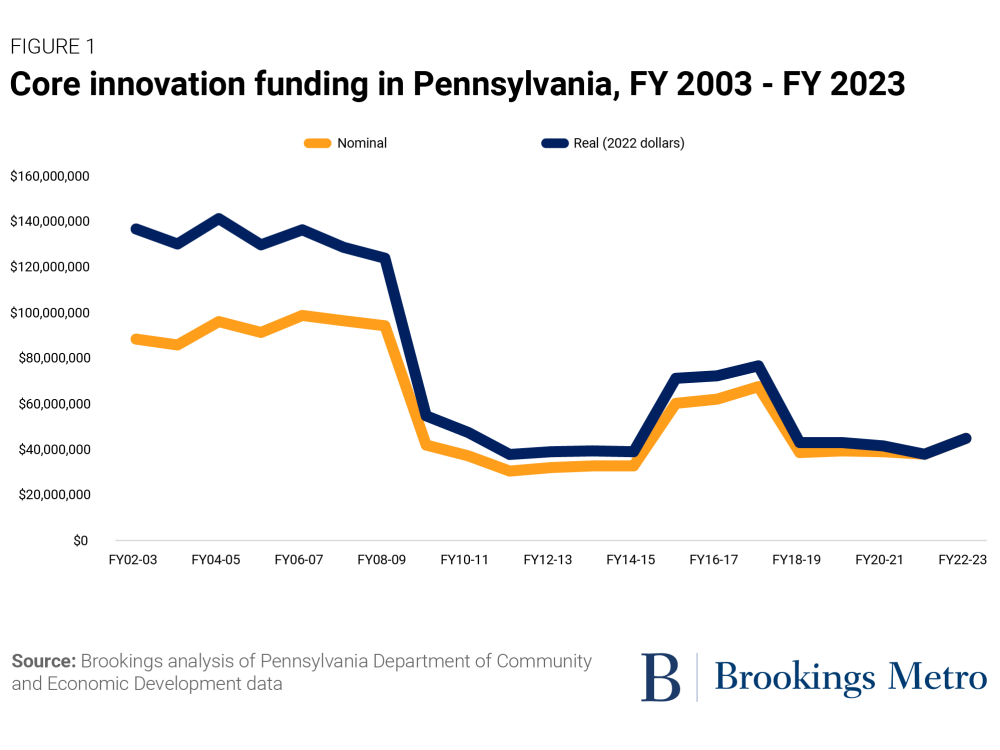Few states possess as many of the assets needed for innovation-driven growth as Pennsylvania. Powerhouse research universities are working on the most critical issues of the day in the life sciences, artificial intelligence, robotics, transportation, and energy. Breakout companies are making headlines and garnering major investments. And the diversity of talent in the state’s cities and rural areas is contributing to a rich capacity for community-based innovation at a time when creativity and inclusion matter more and more.
And yet, for all that, Pennsylvania has not been able to convert its assets into abundant, high-quality economic growth or broad-based employment across an array of high-tech, high-pay advanced industries. Given that, Pennsylvania needs to unlock its innovation potential, which will require catalytic steps on the part of state government.
This report reviews the state’s major innovation trends and challenges, and suggests a set of state-level policy recommendations with an eye toward helping the new governor energize the state’s innovation sector. Overall, the report draws several key conclusions:
Pennsylvania excels at university-based R&D but lags in high-value, high-pay job creation.
On the one hand, Pennsylvania has a rich innovation history, with strong research universities and several groundbreaking innovation programs. The state’s $4.8 billion higher education R&D enterprise ranked fourth-largest in the nation in 2020. At the same time, the state has begun to develop a set of nationally competitive innovation clusters in areas such as the life sciences, computer and information services, robotics, chemicals, and plastics and rubber products.
On the other hand, the state’s accumulation of economically crucial advanced industry jobs has been lagging. From 2010 to 2019, Pennsylvania saw its advanced industry jobs grow by an aggregate 10.9%, trailing the national sector by 8 percentage points. Overall, Pennsylvania ranked sixth out of nine peer states in terms of advanced industry job growth, lagging Indiana and Massachusetts by 9 percentage points and Michigan by 23.
Underlying Pennsylvania’s innovation drift lie four challenges that are holding the state back:
- State government has seemed to lack a clear commitment to innovation and has let its core innovation programs languish. Most starkly, Pennsylvania reduced its investments in innovation programs by nearly two-thirds during the Great Recession, and has failed to rebuild in subsequent years.

- The state lags on converting top-quality research into growth firms and broader employment growth. The state’s above-average concentrations of academic research in fields such as IT are so far failing to translate into above-average employment concentrations in pertinent advanced industries. Another factor depressing innovation-related employment growth is thin startup formation and hiring.

- Meanwhile, innovation is struggling outside of the state’s largest cities. Only about 1% of Pennsylvania’s university-based R&D activity takes place beyond the Philadelphia, Pittsburgh, and State College metro areas. And regions outside the three major innovation metro areas have seen their share of the state’s advanced industry employment decline through the last decade.

- Throughout the state, access to the innovation economy is unequal by race and gender. STEM education, from K-12 through higher education, remains significantly unequal by race and gender in Pennsylvania. This feeds into employment and entrepreneurship, where female, Black, and Latino or Hispanic Pennsylvanians in particular are underrepresented in advanced industry employment and overall firm ownership.

In the face of these challenges, the commonwealth needs to renew its commitment to innovation as a fundamental driver of high-quality, broad-based prosperity.
Given its world-class anchor institutions, promising urban ecosystems, and diverse talent, Pennsylvania possesses vast potential to invent, grow, and participate in the next crucial technology platforms. However, if it is to meet that potential, the state must reclaim its history of supportive policy innovation. To do so, this report presents a finite set of priority themes and recommendations through which state government can catalyze Pennsylvania’s vast innovation potential and reinvigorate its entrepreneurial dynamism:
- Commit to innovation. Today, Pennsylvania’s main innovation programs are mostly adrift, without either adequate funding or high-level advocates in government. The next administration’s top leaders should move urgently to elevate the importance of innovation. Along these lines, the next administration should:
- Embrace the cause of innovation and articulate a strong vision.
- Center innovation in economic development activities.
- Rebuild the innovation budget.
Read more about how Pennsylvania can commit to innovation on page 65 of the report.
- Accelerate commercialization and growth in the state’s major innovation metro areas. Pennsylvania lags in translating its top-quality R&D into growth firms and advanced industry employment. At the same time, reduced state investment has undercut efforts to bolster the vital tech ecosystems that help companies grow, particularly near research universities. Accordingly, the next administration in Harrisburg should:
- Design and support a Pennsylvania Innovation Hubs program as a sizable challenge grant to help regional innovation clusters.
- Aggressively leverage parallel federal cluster programs.
- Expand the state matching fund for federal Small Business Innovation Research (SBIR)/Small Business Tech Transfer (STTR) awards.
Read more about how Pennsylvania can accelerate innovation in the state’s major innovation metro areas on page 68 of the report.
- Foster innovation and entrepreneurship outside of major metro areas. Pennsylvania’s stark regional divides divorce hundreds of thousands of Pennsylvanians from opportunities in big-city innovation centers. To help more of the state’s smaller cities, towns, and rural areas tap into the benefits of the innovation economy, the next administration should:
- Design and fund a competitive challenge grant to catalyze innovation and entrepreneurship in 20 regions outside Pennsylvania’s major metro areas.
- Establish an advanced industries innovation voucher program.
- Continue to strengthen the Penn State LaunchBox and Innovation Network and expand university engagement in local regions more broadly.
Read more about how Pennsylvania can foster innovation in smaller communities on page 75 of the report.
- Insist on inclusion. Without a specific effort to build a more inclusive innovation economy, Pennsylvania risks perpetuating the same inequalities that it has faced for years. Given that, the state should focus on enhancing inclusion in its innovation economy across three themes:
- Grow a more inclusive entrepreneurial ecosystem in both innovation-intensive industries and Main Street entrepreneurship.
- Expand access to advanced industry careers for workers who have been historically underrepresented in those industries.
- Make STEM education more equitable from K-12 through higher education.
Read more about how Pennsylvania can make its innovation economy more inclusive on page 81 of the report.
In order to build a more competitive and inclusive economy in the coming years, Pennsylvania must act now to reclaim its former position as an innovation leader.






